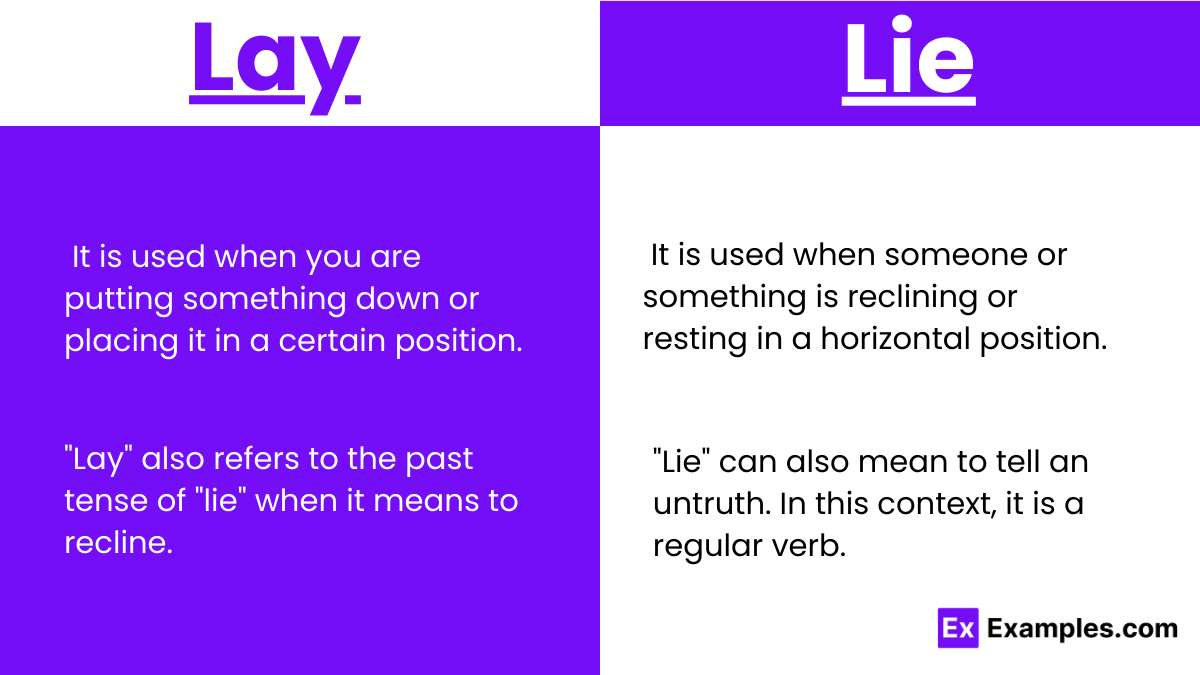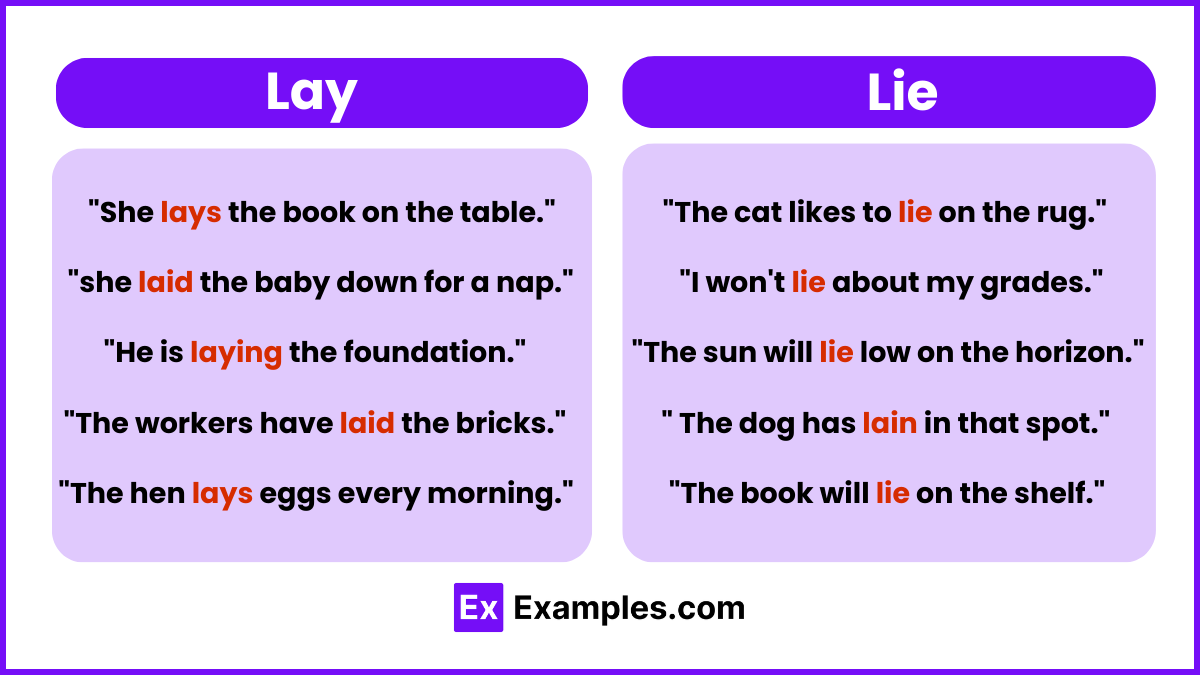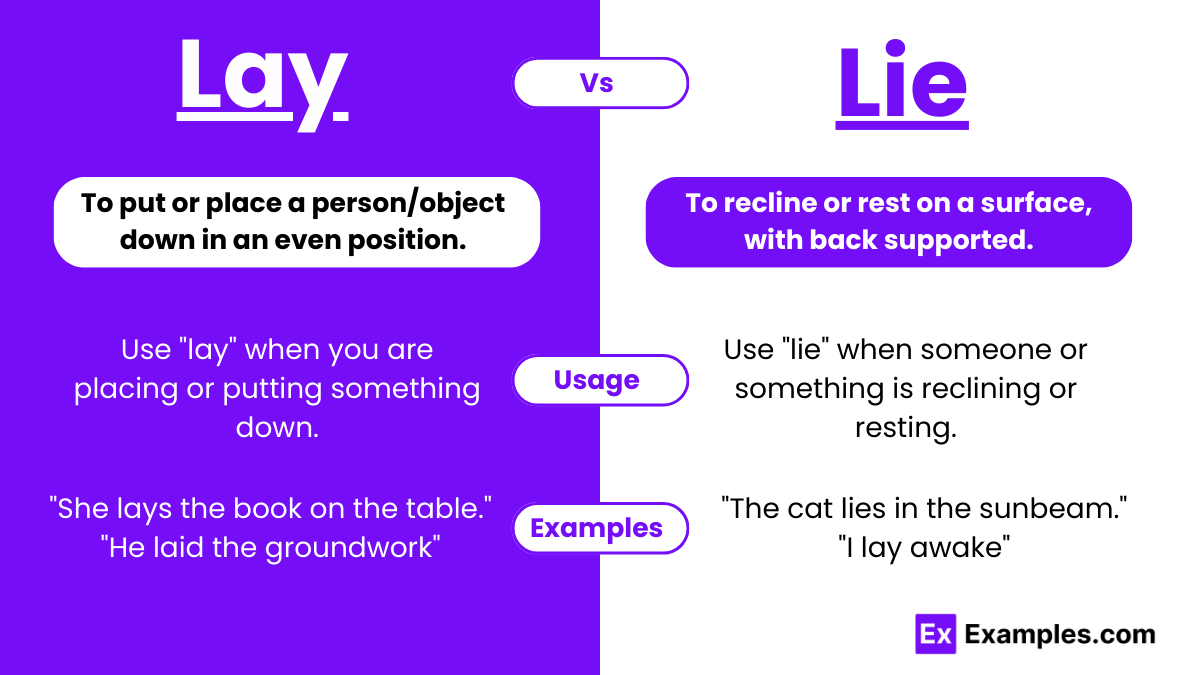Lay vs Lie – Difference, Meanings, Examples, Usage
English can sometimes be tricky, especially when it comes to words that sound alike but mean different things. Two of these words are “lay” and “lie.” “Lay” means to put or set something down, while “lie” means to be in a flat position. These verbs might seem similar, but they have different meanings and uses. Let’s break down the differences between them and learn how to use each one correctly with easy-to-understand examples.
Lay and Lie – Meanings
- Lay is a transitive verb, meaning it requires a direct object to complete its meaning. In the present tense, it is used to describe the action of placing or putting something down. For example, “I lay the book on the table.” In the past tense, laid is used, as in “Yesterday, I laid the groundwork for our project.”
- Lie, on the other hand, is an intransitive verb, meaning it does not require a direct object. It describes a state of reclining or resting. In the present tense, it is used as “I lie down on the sofa to relax.” In the past tense, lay is used, as in “Last night, I lay in bed for hours.”
Summary
The primary distinction between lay and lie lies in their usage as action versus state verbs. Lay requires a direct object and is used to indicate an action of placing or putting something down such as “Please lay the book on the table.” whereas lie describes a state of reclining or resting without the need for a direct object, as in “I need to lie down and rest for a while.” Remembering this distinction can help avoid confusion in using these verbs correctly.
More conjugations of lay and lie
| Verb | Present Tense | Past Tense | Past Participle | Present Participle |
|---|---|---|---|---|
| Lay | Lay | Laid | Laid | Laying |
| Lie | Lie | Lay | Lain | Lying |
How to Pronounce Lay and Lie
- Lay: Pronounced as /leɪ/
- Lie: Pronounced as /laɪ/
Difference Between Lay and Lie
| Aspect | Lay | Lie |
|---|---|---|
| Verb Type | Transitive verb (requires a direct object). | Intransitive verb (does not require a direct object). |
| Action | You put an inanimate object down. | You assume a reclining position. |
| Involvement | Requires an object to act upon. | Does not require an object. |
| Position | It involves an action of placing something. | It involves positioning oneself. |
| Usual Subjects | People or objects. | Animals or people. |
How to remember the difference between Lay and Lie
- Lay needs an object to lay down (like “I lay the book on the table”).
- Lie is what you do by yourself when you recline (like “I lie down on the couch”).
So, if you can put an object after it, it’s probably lay. If not, it’s likely lie.
How to use Lay and Lie

Usage of Lay
- Use “lay” when you are placing or putting something down.
- It is a transitive verb, which means it requires a direct object. You lay something down.
- Example: She lays the book on the table.
- “She” (subject) performs the action “lays” (verb) on the “book” (object).
Usage of Lie
- Use “lie” when someone or something is reclining or resting.
- It is an intransitive verb, meaning it does not take a direct object. Someone or something lies down.
- Example: He lies on the couch to relax.
- “He” (subject) performs the action “lies” (verb), no object needed.
When to use Lay and Lie
Lay Usage
- When you are setting something down on a surface.
- When you are arranging objects or items in a specific position.
- When you are establishing something in a particular location or position.
- When you are causing something to rest or be positioned in a certain manner.
- When you are presenting or arranging something for a purpose.
Lie Usage
- “Lie” is used in English when someone or something reclines or rests in a horizontal position.
- It is used when referring to oneself, another person, or something inanimate resting horizontally.
- “Lie” describes the position of something without indicating an action.
- It is also used when describing a state of being or existence.
Common Mistakes and Confusions
One common mistake is using lay when lie is the correct verb. For example, saying “I’m going to lay down for a nap” is incorrect; it should be “I’m going to lie down for a nap.” Similarly, using lie when lay is needed can lead to confusion, such as saying “I’m going to lie the book on the table.”
Tips for Correct Usage
To remember the difference between lay and lie, consider using mnemonics or memory aids. For instance, think of the phrase “I lay the book down” and associate it with the action of physically placing something down. Conversely, “I lie down to rest” reflects the act of reclining without any object involved.
Examples of Lay and Lie

Lay Examples:
- Present tense: She lays the papers out before starting her work.
- Past tense: Yesterday, I laid the book on the table.
- Past participle: I have laid the book on the table.
- Present participle: They are laying the groundwork for the project.
Lie Examples:
- Present tense: She lies on the couch when she watches TV.
- Past tense: Yesterday, I lay on the bed for hours.
- Past participle: I have lain awake all night.
- Present participle: They are lying on the beach enjoying the sun.
Synonyms
| Lay | Lie |
|---|---|
| Place | Recline |
| Put | Rest |
| Set | Be situated |
| Position | Be located |
| Arrange | Be at rest |
Exercise
- She ________ the baby down for a nap.
- The cat loves to ________ in the sunbeam.
- Yesterday, he ________ the blanket on the bed.
- The book has been ________ on the table for hours.
- The truth tends to ________ somewhere in the middle.
Answers
- lay
- lie
- laid
- lying
- lie
FAQ’S
Do I lay in bed or lie in bed?
Use “lie” in bed as it’s intransitive; one reclines without an object. “Lay” requires an object to act upon.
How do you use lie and lay?
Use “lie” when reclining without an object. Use “lay” when placing something down or arranging objects.
Do you lay or lie on the couch?
You “lie” on the couch because it indicates reclining without acting upon an object directly.
Is it lay around or lie around?
Use “lie around” as it denotes reclining without a direct object, unlike “lay.”
Is it lie awake or lay awake?
Use “lie awake” as “lie” is intransitive; it describes the state of being awake without acting on an object.



